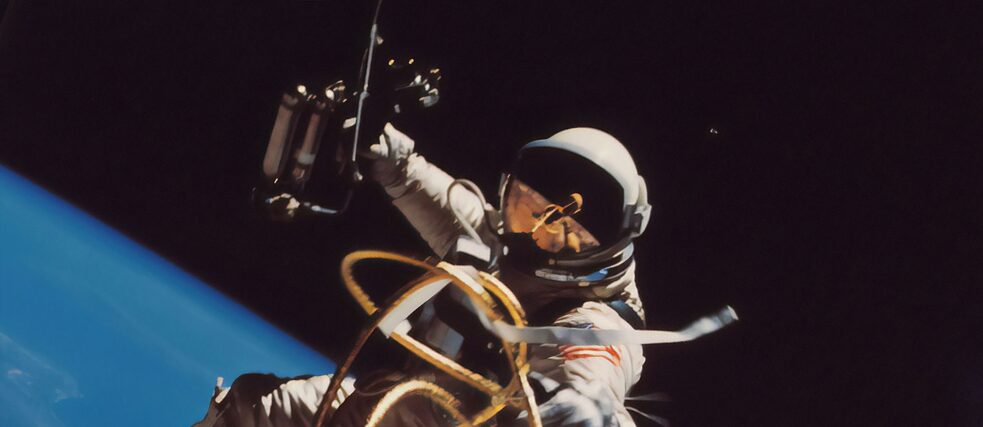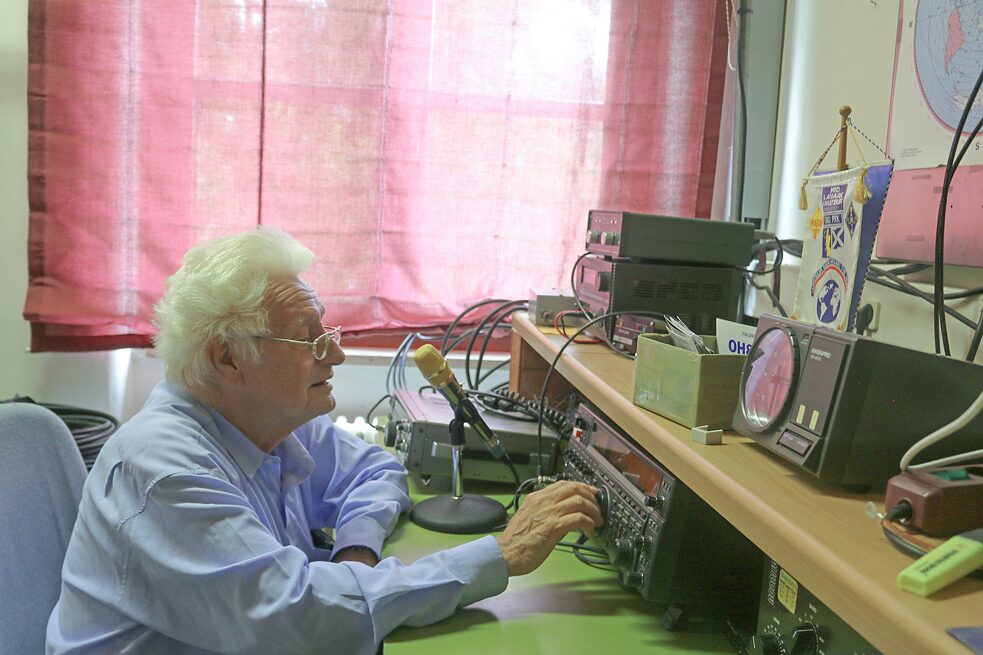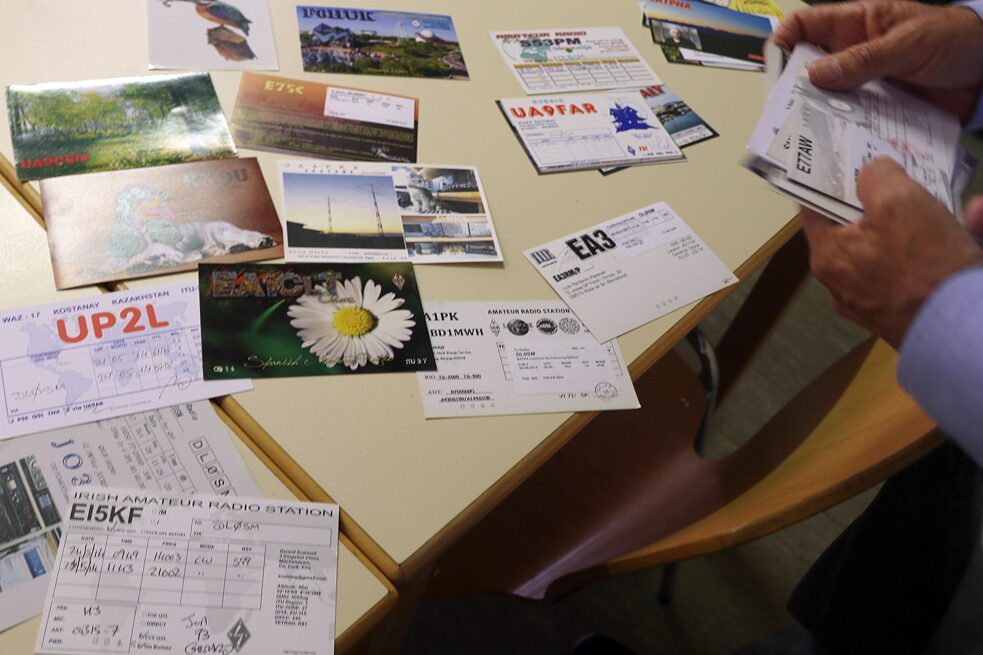Ham radio
“I confirm receipt of your transmission”

It is relatively easy to connect with the International Space Station (ISS). You need a suitable transceiver, a licence and a little bit of luck.
By Natalia Mleczko
The radio transmitter in the club room of the German Amateur Radio Club (DARC) in Schweinfurt, Lower Franconia, crackles and hisses. “It’s not always like this”, says Klaus-Dieter Jones, the local branch chairman and a passionate amateur radio operator. He turns a dial, and before long a signal can be heard: “Echo – America – Three – Japan – Echo,” someone calls in a voice very distorted by the radio. Other obscure terms can be heard coming from the black device the size of a somewhat bulky radio. To a layperson, the code is practically incomprehensible. “Echo – America – Three – Japan – Echo,” the radio voice repeats. To Klaus-Dieter Jones, this is anything but a secret code. He understands the call straight away. A Russian amateur radio operator is trying to contact a Japanese colleague. “There’s not a lot going on at the moment,” comments the radio veteran. “There’s much more traffic at the weekend.”
In all zones across the world
The man from Lower Franconia has had a close connection with amateur radio for nearly half a century. Numerous amateur radio diplomas adorn the club room walls. One diploma says ‘Worked all Zones’, certifying that Jones has managed to establish radio connections to all zones of the world. He has also achieved several connections to receivers in outer space. A vast collection of what are known as ‘QSL cards’ attests to his unwavering commitment. Amateur radio operators receive these cards to confirm two-way radio contact. In Morse telegraphy, QSL means: “I confirm receipt of your transmission.” Radio operators collect these the way children collect Panini football stickers.Amateur radio enthusiasts
In an age of smartphones, social media platforms and messenger services, amateur radio may seem something of a throwback to a bygone age. Far from it, though: amateur radio is alive and kicking. There are an estimated two to three million amateur radio enthusiasts worldwide. Nearly 70,100 amateur radio call signals were assigned in Germany alone in 2022. Anyone wanting to transmit independently via radio needs a licence. The test for licence applicants is administered by the German Federal Network Agency (Bundesnetzagentur). The agency granted nearly 1,480 amateur radio approvals in 2022. There are nearly 2,800 club stations in Germany. Spread across Germany, these stations provide a location from which licensed radio amateurs can transmit their radio messages. This is where interested visitors can look over the shoulders of radio hams in action.“We’re surrounded by radio signals all the time and everywhere,” says Stefan Hüpper of the DARC national headquarters in Baunatal. “There is a huge need for communication,” the editor-in-chief of the amateur radio magazine CQ DL points out. “The things transmitted over radio frequencies might be voice, Morse telegraphy or even television pictures,” explains Hüpper. With this hobby, the range is vast. The club is heavily involved in youth outreach. “From amateur radio operator to engineer,” Hüpper says. There are quite a few examples of young people who experience amateur radio early in life and who then go on to pursue technical careers. DARC hopes to unleash the ‘radio virus’ through intensified youth work. The club even gives up-and-coming radio operators an opportunity to make so-called ‘school contacts’ with the International Space Station. This is offered through the ARISS (Amateur Radio on the International Space Station) project. DARC participates in the project in its capacity as a German amateur radio club.
Human outpost
Launched in 1996, the ARISS project facilitates contact with the International Space Station. This is an international working group of amateur radio operators from 15 countries, and its work is carried out almost entirely by volunteers. The project aims to encourage children’s and teenagers’ interest in science, technology, engineering and mathematics. The young people learn about space research, space technologies and satellite communication. Some 1,600 radio contacts with man’s highest outpost have been established to date.“Radioing with the ISS is relatively easy,” says Oliver Amend, Chairman of ARISS Europe. All an amateur radio operator needs is a suitable radio transmitter that operates in a certain frequency range, a directional antenna and software to determine the precise position of the ISS. The orientation of the antenna has to be right – and it takes a little luck, too. The opportunities to contact the ISS, and the astronauts on board in particular, are limited. That makes sense; after all, astronauts have work to do in space. This is why school classes or universities must apply for selection. The ISS awards ten to 15 contacts to groups in Europe every six months.
It usually receives around 20 to 25 applications. ARISS advises and assists school classes during the process, and lays down the procedure on the day of radio contact. “That’s when we discuss technology. A query goes out asking if everyone is ready,” says Amend. The connection to the ISS lasts just ten to twelve minutes. As Amend points out, though, these connections are very intense experiences: every time contact is successful, children’s eyes light up and teachers get a real adrenaline kick. Alongside this option, contact to the ISS is also possible via crossband repeater mode. “It's available to anyone who is licensed, and it works very easily”, says Amend. All that’s needed is a suitable radio transmitter – even a hand-held radio will do – and an antenna aligned with the position of the ISS in the sky. Software to determine the position of the ISS is also needed. The radio must be set to the receiver frequency of the ARISS converter. “With a little practice, patience – and, above all, luck – the call placed over the transmitter frequency will pay off”, Amend says. Because it is quite possible that an astronaut will be transmitting the signal ‘CQ, CQ, this is NA4ISS calling for random contact’ in a free moment. This means that there is an astronaut seeking to make contact. And that is truly a stroke of good luck for any amateur radio ham.
Helping to promote international understanding
But amateur radio is about much more than an old-fashioned means of communication and an exciting foray into outer space. “Amateur radio helps if our telecommunications networks break down,” explains Andrzej Łaczmański, a maintenance engineer for cellular networks in Szczecin, Poland. “In 1997, when the flood of the century spilled over the banks of the Oder, amateur radio operators disconnected the batteries from their cars and used them to transmit vital information to a variety of services from their rooftops,” Łaczmański recalls.Not only does amateur radio help others in natural disasters, but it also promotes international understanding. This is the conclusion of Łaczmański, but also of Klaus-Dieter Jones, who had the great fortune to radio with Neil Armstrong, the first man on the moon. “This has led to lots of international acquaintances – from the Far East and America, for example,” reports Jones, visibly proud of a hobby that has enthralled him now for almost half a century.

